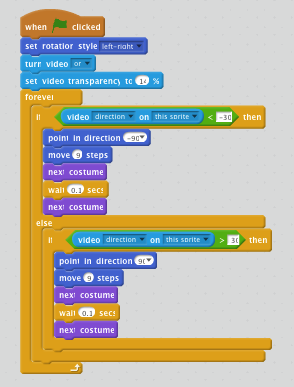Still enjoying playing with Scratch and webcam. in this post, initially improving on the example shown in a previous post Webcam and Scratch; enhancing the movement of Scratch the Cat by adding the interim step and facing in the direction of the 'moving finger' (see the code below).
Please go to the code at https://scratch.mit.edu/projects/263334488/ to try it yourself.
Going to add one more feature to experiment with getting objects to react to the motion. In this case to explode a button or change a button to a small ball by moving the finger onto the button. The motion on the sprite is used to do this.
Please try the code yourself at https://scratch.mit.edu/projects/266837380/
All opinions in this blog are the Author's and should not in any way be seen as reflecting the views of any organisation the Author has any association with. Twitter @scottturneruon
Please go to the code at https://scratch.mit.edu/projects/263334488/ to try it yourself.
Going to add one more feature to experiment with getting objects to react to the motion. In this case to explode a button or change a button to a small ball by moving the finger onto the button. The motion on the sprite is used to do this.
Please try the code yourself at https://scratch.mit.edu/projects/266837380/
All opinions in this blog are the Author's and should not in any way be seen as reflecting the views of any organisation the Author has any association with. Twitter @scottturneruon



Comments
Post a Comment